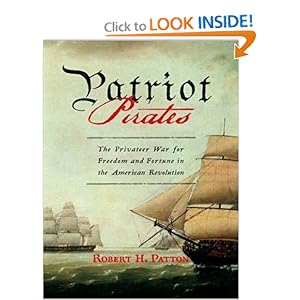(Amazon's link
)
The focus is primarily upon the New England privateers, particularly out of Rhode Island and Massachusetts. It emphasizes the role played by privateers in the success of the revolution and how the investors and privateers became some of the most wealthy men post-Revolution.
He begins with an incident where the HMS Gaspee was burned by Rhode Islanders because the Gaspee was doing too good of a job enforcing the tariffs on incoming goods to the colony. The men who backed the attack, would become some of the most influential financiers of the war.
The huge number of small ship actions that occurred between these privateers and the Royal Navy, Merchant Marine or Loyalist Privateers open a large possibility for the gaming table. A campaign system that tracks the success of these privateers started coming to mind.
What Patton paints is a picture of the vast scope of the privateering endeavor. When one looks for losses on the sea during the Revolution, only the state navies and the Continental Navy has their casualties listed in most histories. The privateers are left out as they were not real navy. Yet these amateurs inflicted some of the most serious losses upon the British and provided the Continental Army with much of its supplies. Yet the losses among the privateersmen were staggering. Pension applications of coastal towns show in some cases 50 to 100% losses among the men who so served. While the Continental Navy suffered less than 900 men killed, the losses of the privateers were in the thousands.
One comment by Patton was that "Daring as they were, most privateersmen were sea faring novices who could not find a rope in the night much less match the gunnery skill of British professionals." This would match with the losses that they suffered. The manic pace of raising privateers led to less and less seasoned crews being sent out. Their success rate was such that one successful cruise could pay for two unsuccessful ones or the loss of the vessel and its crews. Privateering was a lucrative business that even Generals among the Continental Army gambled in.
So far, all of my interest in the Revolution has been the campaigns in the Southern Theater, I immediately got to work on what happened locally. It seems that Charleston was a very active harbor in the South and produced a number of privateers as well as equipping and creating a navy of its own. From 1775 to 1780, Charleston was a very important hub of activity. A large number of naval battles and landing actions took place around or near Charleston Harbor.
Given my penchant for liking the early part of any war, I began to look up scenarios for 1775 and 1776 around Charleston Harbor to use for either Kiss Me Hardy or Sharp Practice.
This and I have a small Frigate that needs to get on a table at some point are really proving to be a distraction.
If you want to get caught up in my distraction, here is a little website that I highly recommend: http://www.awiatsea.com . It has provided a wealth of information on the period for me as well as some superb info on ships and their commanders. I highly recommend it.
Now where did I put my copy of KMH... Oh, there it is.

Chris,
ReplyDeleteGet cracking!
Joe
Hi Chris,
ReplyDeleteScenarios based on privateers sounds like fun. You might want to look for French or Spanish actions v. the British as the coastal waters off Amelia and Cumberland and Amelia Islands north to Norfolk had many hiding places and still remembered Blackbeard's activities against British commerce coming up from the Gulf Stream. You may also want to consider possible actions in the Gulf around Pensacola and Mobile. I look forward to what you find and will pick up KMH.
Cool idea. Do you have a good reference for this?
Delete